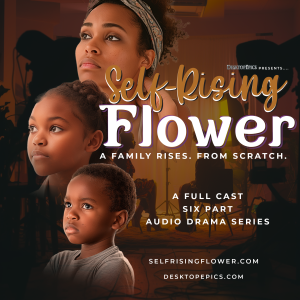Self-Rising Flower – From Podcast to Novel – Part 2
Welcome to the second entry in my writing development journal, where I’ll document the process of adapting our podcast, Self-Rising Flower, into a novel. Whether you’re a seasoned writer or just beginning to explore storytelling, I hope this journal inspires and offers insights into the creative journey.
My Writing ProcessWhen I begin a story, it starts with rumination. I sit with the idea for a while, asking myself: What do I want the reader or audience to feel when it begins? When it ends? From there, I begin crafting a synopsis or treatment, often starting with: “The film starts with…” or something similar. It doesn’t need to be rigid; the goal is to capture the broad strokes of the story.
Once I’ve run through a few iterations of the plot, including key points I feel are critical, I create a blueprint that aligns with the medium. If it’s a film, I don’t box myself in with traditional “acts.” Instead, I focus on the situation and how to tell a fluent, engaging story. For novels, I break the blueprint into chapters: Chapter One, this happens; Chapter Two, that happens, and so on. This process helps me stick to the path I’ve laid out, minimizing the temptation to constantly rewrite and extend the project unnecessarily.
Blueprinting is crucial. Once the story’s skeleton is finalized, you stick to it and finish the whole thing. People often evolve stories mid-way, but this can prolong the process endlessly. You’ll always find a reason to add to a story without finishing the original draft. It’s fine to allow evolution, but major changes should be saved for sequels. Develop the story, finalize the blueprint, and stick to it.
This is especially for those people that have been saying ‘I’m been thinking about writing a book one day’ and haven’t dropped a sentence yet. Do it already.
 Character Development
Character DevelopmentSome writers prefer to build complex characters first, with detailed backstories and motivations. While this is valid, my approach differs. I like to develop characters based on the situations they face. Life teaches us that we often don’t truly know who we are until confronted with a challenge we’ve never faced before.
Here’s an example: Imagine a character jumps out of a plane without a parachute. How do they survive? This scenario forces you to explore their ingenuity, courage, or desperation. Perhaps they’re a drama character with no special skills. What’s their mental state? How does their backstory inform their choices? By focusing on the moment, you naturally uncover traits and layers that make the character compelling. This exercise forces you to think and create out of your comfort zone.
I also borrow traits from people I know. Maybe someone in real life is lazy but has a sharp wit. Putting that trait into a high-stakes scenario generates fascinating possibilities. Letting characters breathe and interact naturally in these situations allows me to build their arcs authentically. This method guided much of the dialogue and character dynamics in Self-Rising Flower. For example, Aniyah’s unfiltered common sense emerged organically through her interactions.
Writing Against Your ValuesWhen it comes to storytelling, you must be ready to write against your personal values. Authenticity often requires exploring perspectives and situations you don’t connect with. I can name countless topics I don’t personally like or understand, but the challenge lies in writing them with genuine respect and without being a dick.
My short story, The Trash We Carry, was an exercise in this. It required me to write about people and experiences outside my comfort zone, but doing so broadened my perspective and taught me a lot. Writing stories about things you don’t connect with helps you grow as a storyteller and deepens your ability to create larger, more inclusive narratives. Otherwise, your writing just comes off as someone who doesn’t understand a people or culture and the hate can be heard/felt in the text — unless it’s in context of a specific character, of course.
Self-Rising Flower and Revisiting ChoicesThe original six parts of Self-Rising Flower are hardcoded now publically listened to around the planet, and while the story worked well, there was an early element I regret removing: Aniyah’s father.
Initially, he played a subtle background role, offering advice to Aniyah as she helped Erika build Erika D’s.
I removed him after taking advice that questioned the inclusion of father figures in a single mother’s success story. However, looking back, I feel the absence of a father character feeds into the tired narrative of absent, deadbeat dads. Aniyah’s father was meant to provide balance—present in her life, offering guidance, but disconnected from Erika due to their complicated relationship.
Adding him back creates a richer dynamic. His involvement with Aniyah, contrasted by his reluctance to connect with Bryson (her brother and Erika’s son), introduces a flaw that deepens his character and heightens the tension. It’s storytelling unfiltered—messy, real, and layered.
 Structuring the Novel
Structuring the NovelThe first six chapters of the novel will follow the audio drama, with added depth for side characters and expanded scenes. This ensures readers who enjoyed the podcast will feel familiar while discovering new elements.
Chapters 7-12 will expand the story beyond the audio drama’s conclusion. This part of the blueprint focuses on Erika’s journey after the wedding and the significant time shift that follows. Fortunately, I wrote much of this a year ago, so tightening it now feels more like sculpting than creating.
The novel begins with a prologue that sets up the events before the audio drama’s first episode, showing Erika at her overnight job as she starts feeling destined for something more. The prologue and parts of Chapter One are already complete, and I aim to finish the first six chapters by the end of February. The key is to avoid editing as I go, staying true to the story’s core while layering in the details that make it richer.
This journal entry captures my approach to writing Self-Rising Flower as a novel. It’s about sticking to the blueprint, breathing life into characters through their situations, and revisiting decisions to create a more honest, engaging story.
The post Self-Rising Flower – From Podcast to Novel – Part 2 appeared first on DesktopEpics Entertainment.



